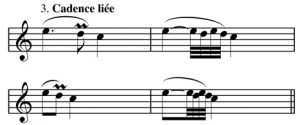Trill (cadence or tremblement) consists basically of an indefinite number of alternations of the upper auxiliary and the written note (Ex. 1):
In performance it has three variable components:
1. Appuy: appoggiatura, or preparation (the note above the note that has the trill sign)
2. Battemens: beats, alternations, or repercussions of the two notes
3. Endings: consisting of three possibilities:
a) Liaison: where the note of resolution is preceded by an anticipation (Ex. 2a):
b) Tour de gosier: where a turn leads to the note of resolution (Ex 2b):
c) Point d’arrêt: where the trill stops on the written note before resolving directly (Ex 2c):
Methods of Performance of the Trill
1. Cadence apuyée: Preparation held about half the time (Ex. 2d):
2. Cadence subite: Preparation not held; beats begin immediately (as in Ex. 1):
3.Cadence liée: Tied trill — preceding note (M or m 2nd above) slurred to the trilled note, and in performance tied over into the beginning of the trilled note, so the appuy itself is not articulated (Ex. 3):
4. Cadence imparfaite: Short trill on rapid note (called imperfect because it lacks held preparation and ending). Four notes is enough (Ex. 4):
5. Cadence coulée: Trill with introductory turn (Ex. 5):
6. Double cadence: Trill at cadence extended backwards with a mordent and turn on the preceding dotted note. The sign-post is two consecutive dotted figures in the notation approaching a cadence. The three ornaments should be played without interruption (Ex. 6a & 6b):










